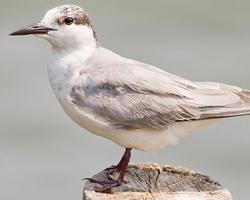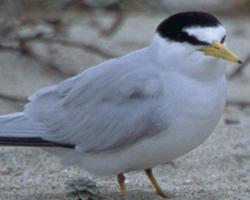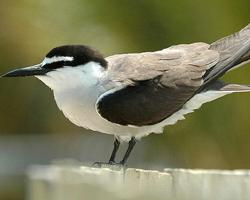
Statut de conservation
| Menacé |
Description de l'animal
The Little Tern (Sternula albifrons) is a diminutive and graceful seabird that belongs to the family Laridae, which encompasses gulls, terns, and skimmers. Known for its agility in flight and distinctive fishing technique, this bird is a fascinating subject of study for ornithologists and a delightful sight for birdwatchers.Physical Description:
The Little Tern is one of the smallest members of the tern family, with a body length typically ranging from 21 to 25 cm (8.3 to 9.8 inches) and a wingspan of about 41 to 47 cm (16 to 18.5 inches). It possesses a slender, streamlined body, adapted for swift flight and sudden dives. Its plumage is predominantly grey and white, which serves as excellent camouflage against the coastal and marine environments it inhabits. During the breeding season, adults exhibit a striking black cap on their heads, a sharp contrast to their white forehead and cheeks. The bill is slender and pointed, usually bright yellow with a black tip, while the legs are relatively short and also yellow in color. Non-breeding adults and juveniles show more muted colors, with the black cap replaced by a mottled grey and the bill and legs less brightly colored.
Habitat and Distribution:
The Little Tern has a broad geographical range and can be found across coastal regions of Europe, Asia, Africa, and Australasia. It prefers shallow, sheltered waters such as estuaries, lagoons, and river mouths, as well as sandy or shingle beaches and islands where it can nest and feed. Despite its wide distribution, the species faces threats from habitat destruction and disturbance in many areas, leading to local declines in population.
Behavior and Diet:
This species is highly adapted to a life spent mostly in the air or on the water. It feeds primarily on small fish, which it catches with remarkable skill. Hovering over the water, it spots its prey and then plunges headfirst into the water to snatch it up. Little Terns are also known to feed on crustaceans and insects, making them versatile hunters.
Reproduction:
Little Terns are colonial nesters, often forming breeding colonies with other tern species. They exhibit strong site fidelity, returning to the same breeding grounds year after year. Nests are simple scrapes in the sand or gravel, into which the female lays typically two to three eggs. Both parents share incubation duties and later, the care of the hatchlings. The chicks are precocial, meaning they are relatively mature and mobile from the moment of hatching, but they rely on their parents for food and protection until they are ready to fledge.
Conservation Status:
Globally, the Little Tern is considered to be of Least Concern by the International Union for Conservation of Nature (IUCN), thanks to its extensive range. However, in specific regions, populations are under pressure or in decline due to human activities such as coastal development, recreational disturbance, and pollution. Conservation efforts are in place in many areas to protect breeding sites, including the creation of protected areas, installation of signage to reduce human disturbance, and the use of wardens to monitor colonies during the breeding season.
In conclusion, the Little Tern is a remarkable bird, showcasing the beauty and complexity of avian life. Its presence enriches the ecosystems it inhabits, and its behavior and life cycle offer valuable insights into the intricate balance of coastal environments. Conservation efforts to protect this delicate species are essential to ensure that future generations can continue to marvel at its aerial acrobatics and contribute to the biodiversity of our planet.
Animaux similaires
Nouvelles photos d'animaux
Top 10 des animaux
- Dolphin gull (Leucophaeus scoresbii)
- Diana monkey (Cercopithecus diana)
- Moustached guenon (Cercopithecus cephus)
- Galápagos tortoise (Geochelone nigra complex)
- Japanese macaque (Macaca fuscata)
- Stone loach (Barbatula barbatula)
- Russian tortoise (Testudo horsfieldii)
- Greek tortoise (Testudo graeca)
- Common flying dragon (Draco volans)
- Vendace (Coregonus albula)


